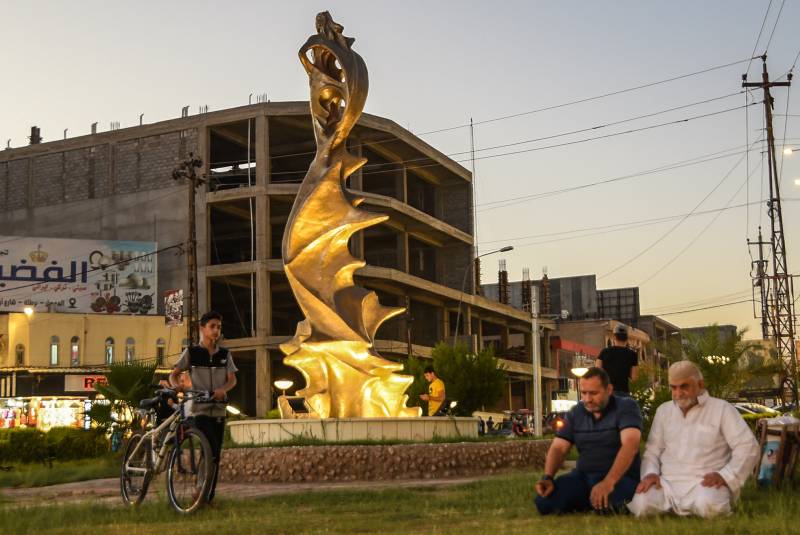In Iraq's Mosul, new statues rise from ashes of IS rule

Stay tuned with 24 News HD Android App

As sunset nears, the residents of Iraq's Mosul flock to a golden-tinted statue of a woman looking out over their scarred city with an expression of steady defiance.
It is one of a half-dozen works by local artists that have been erected across the northern Iraqi city since the Islamic State group lost control of it three years ago.
The artworks are helping residents shake off memories of brutal punishments meted out by IS in squares and roundabouts, even as much of their city remains in ruins.
"My Lovely Lady" was the first, erected in September 2018 in a traffic circle where IS fighters used to behead or lash residents who had broken its ultra-conservative rules.
"By placing this statue here, I was trying to erase these dark, terrifying images from people's minds," said Omar Ibrahim, the 35-year-old artist behind the work.
"'My Lovely Lady' represents Mosul's beauty, its rebirth after overcoming all the obstacles of this nerve-wracking period," he told AFP.

Nerve-wracking it was: Ibrahim created the sculpture in a secret basement studio while the IS was still controlling Mosul.
When they first overran the city, the jihadists smashed works of art, musical instruments and millenia-old artefacts, deeming them violations of their ultra-conservative views.
They banned artists from working under penalty of death.
It was a devastating blow for Mosul, which had been known for centuries as a hub for musicians, writers and artists.
- Symbols of a city -
One favourite destroyed by IS was "The Spring Girl," a young woman carrying a bouquet and buffeted by the wind.
Mosul is known as "The Mother of Two Springs" because of its mild weather in both spring and autumn.
A remake of the sculpture of a woman with flowing hair and a sly half-smile was erected this year against a backdrop of a bullet-riddled building, a reminder of Mosul's grim recent history.
Another was "The Licorice Man," which dated back to the 1970s and depicted a street peddler with the beloved candy.
A team of young sculptors has made a new version, which has become such a landmark that the whole area is now dubbed the "Licorice Circle" by residents.
Jihadists also pulverised statues of the poet Abu Tammam and celebrated ballad virtuoso Mulla Uthman, whose remakes were recently installed in western Mosul.
While their predecessors were made of local Mosul stone or bronze, the replacements are made of cheaper metal.

Mosul's municipality is looking to pepper the city with more historical symbols, said Fares Mohammad, a local official from the Building Unit.
One statue he wants to see installed is of Ibn Sina, the father of early medicine more commonly known as Avicenna, to honour Mosul's past as a destination for top-tier medical care.
"These statues represent Mosul's cultural identity, its life, its professions and even its four seasons -- especially spring, which is beautiful here," said Ziad al-Sumeidi, a history and heritage researcher.
- 'Our devastated Mosul' -
Little of Mosul's rich history is visible today.
Besides the IS reign of destruction, the gruelling and months-long fight to recapture the city from the jihadists ravaged its infrastructure, particularly in the western half.
Only one public hospital now functions, power and water services are intermittent, and children must walk past crumbling buildings to get to the few schools that have reopened.
The poor living standards mean hundreds of thousands who were displaced from Mosul in recent years still prefer to live in tented camps rather than return to their scarred home town.
Those who have come back can often be seen relishing a quiet moment near the statues in the evenings.
Hadeel Najjar, a 30-year-old housewife, said she was glad to see the larger-than-life figures revive her hometown -- and hoped that her fellow Mosul residents can return, too.
"Erecting these statues is a necessary part of bringing life back to our devastated Mosul," she told AFP.
"But people still aren't coming back to their homes and shops, because of delays in compensating war victims or rebuilding the city's infrastructure."
